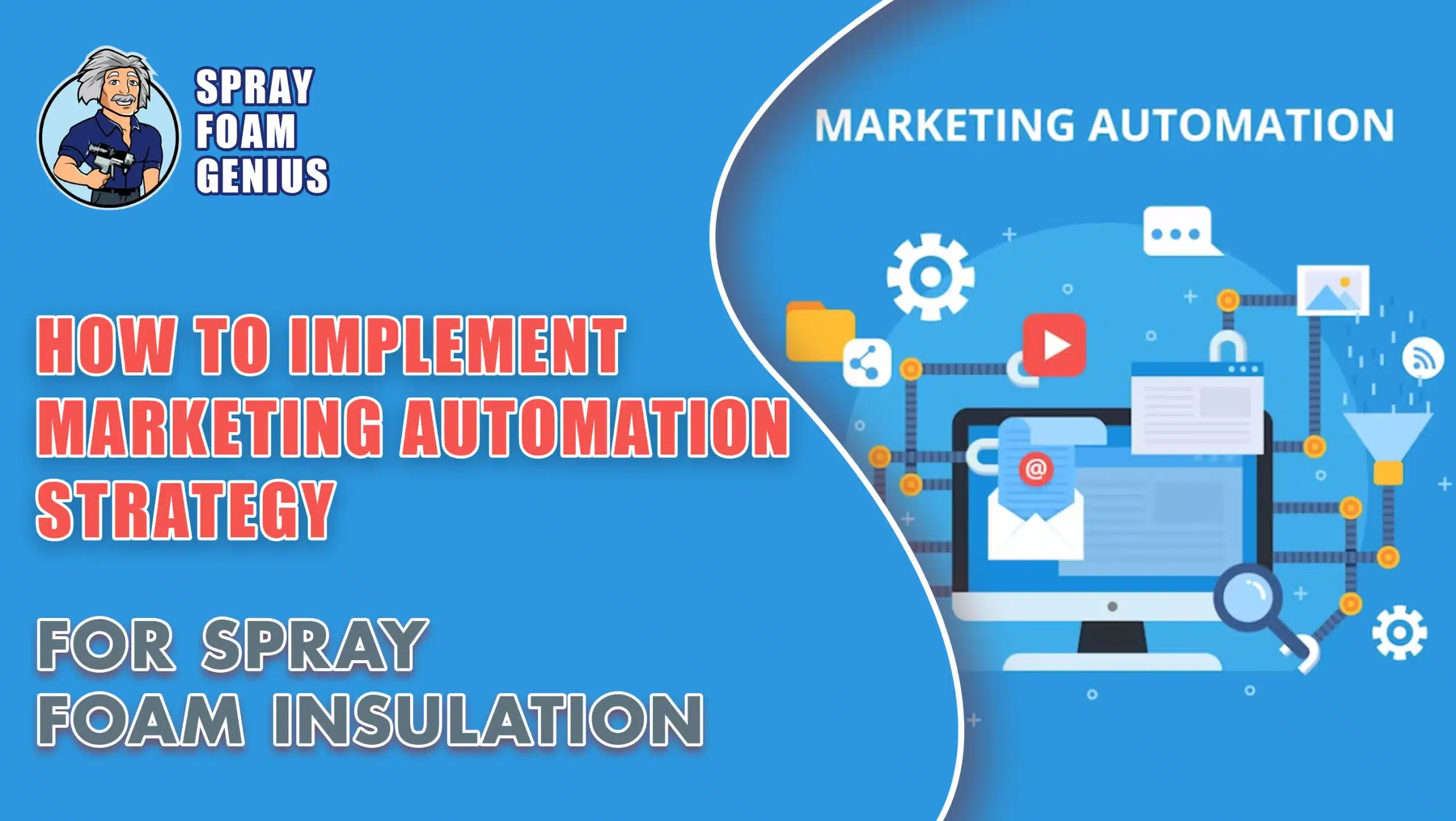
In the competitive world of spray foam insulation, marketing automation is not just a luxury—it’s a necessity. With an increasing number of contractors vying for the same customer base, having a streamlined and efficient marketing strategy can significantly impact your business success. Marketing automation allows you to engage with potential customers more effectively, nurture leads, and ultimately drive more conversions. At Spray Foam Genius Marketing, we understand the unique needs of spray foam insulation contractors and specialize in creating tailored marketing automation strategies that align with your business goals. This guide will walk you through the essential steps to implement a marketing automation strategy that works for you.
Understanding Marketing Automation: What It Means for Your Business
Marketing automation involves using software to perform marketing tasks automatically, rather than manually. For spray foam insulation contractors, this could include automating email campaigns, lead nurturing, social media interactions, and customer segmentation. The primary benefits of marketing automation are enhanced efficiency, increased personalization, and improved lead management.
Key Benefits of Marketing Automation
- Efficiency: Automate repetitive tasks to free up time and reduce manual effort. This includes automating responses to inquiries, follow-up emails, and social media posts.
- Personalization: Deliver targeted content based on customer behavior, preferences, and engagement history. Personalized communication is more likely to resonate with potential customers.
- Lead Nurturing: Engage with leads through automated workflows designed to guide them through the buyer’s journey. This helps in building relationships and increasing the likelihood of conversion.
- Data Analysis: Gain insights into marketing performance through analytics. Track metrics like email open rates, click-through rates, and conversion rates to refine your strategy.
Setting Clear Objectives for Your Marketing Automation Strategy
To implement a successful marketing automation strategy, start by setting clear objectives. This will help you focus your efforts and measure the success of your campaigns.
Common Goals for Spray Foam Insulation Contractors
- Generating More Leads: Use automation to attract and capture potential customers through lead generation forms and targeted campaigns.
- Improving Conversion Rates: Automate follow-up emails and nurturing workflows to guide leads toward making a decision and ultimately converting.
- Enhancing Customer Engagement: Provide timely and relevant information through automated emails and social media interactions.
- Increasing Efficiency: Streamline marketing processes to reduce manual work and ensure consistent communication.
Choosing the Right Marketing Automation Tools
Selecting the right tools is crucial for the success of your marketing automation strategy. Various platforms offer different features, so it’s important to choose one that fits your needs.
Factors to Consider When Choosing a Tool
- Features: Look for a platform that supports key features such as email marketing, lead management, CRM integration, and analytics. Tools like HubSpot, Mailchimp, and ActiveCampaign are popular choices.
- Ease of Use: Opt for a user-friendly tool that aligns with your team’s technical skills. A complex tool may require extensive training and slow down your implementation.
- Integration Capabilities: Ensure the tool integrates seamlessly with your existing systems, including your CRM and website. This allows for a cohesive marketing approach.
Developing a Comprehensive Marketing Automation Plan

With the right tools in place, it’s time to develop a comprehensive marketing automation plan. This plan should cover audience segmentation, content creation, workflow design, and lead scoring.
Audience Segmentation
Segmentation involves dividing your audience into groups based on demographics, behavior, and interests. This enables you to tailor your messages and offers to each segment, increasing relevance and engagement.
- Demographics: Group leads based on factors such as location, age, and job title.
- Behavior: Segment based on interactions with your website, emails, and social media.
- Interests: Create segments based on specific interests or needs related to spray foam insulation.
Content Creation
Content is at the heart of marketing automation. Develop a range of content types that resonate with your audience and support your objectives.
- Email Templates: Design email templates for different stages of the buyer’s journey, including initial outreach, follow-ups, and promotions.
- Landing Pages: Create compelling landing pages with clear calls to action to capture leads and drive conversions.
- Social Media Posts: Schedule and automate social media posts to maintain an active online presence.
Workflow Design
Automated workflows guide leads through a series of actions based on their behavior and engagement. Design workflows for various scenarios, including:
- Lead Nurturing: Create a sequence of emails that provide valuable information and keep leads engaged.
- Follow-Ups: Set up automated follow-ups for leads who have shown interest but haven’t yet converted.
- Customer Onboarding: Develop an onboarding sequence to welcome new customers and provide them with essential information.
Lead Scoring
Lead scoring involves assigning values to leads based on their engagement and potential. This helps prioritize leads who are more likely to convert.
- Engagement: Score leads based on their interactions with your emails, website, and content.
- Demographics: Consider factors such as job title, company size, and location in your scoring model.
- Behavior: Monitor actions such as downloading content or requesting a quote to assess lead quality.
Implementing and Testing Your Automated Workflows
With your plan in place, it’s time to implement and test your automated workflows. This involves setting up your campaigns, monitoring performance, and making adjustments as needed.
Setting Up Campaigns
Begin by configuring your email sequences, lead generation forms, and other automation processes. Ensure that all elements are properly integrated and functioning.
- Email Sequences: Set up your email automation sequences according to the workflows you’ve designed.
- Lead Forms: Create and embed lead capture forms on your website and landing pages.
- Integration: Verify that your automation tool integrates with your CRM and other systems.
Testing and Optimization
Testing is essential to ensure that your automation processes work as intended. Conduct A/B tests to compare different versions of your emails, landing pages, and other content.
- A/B Testing: Test variations in subject lines, email content, and calls-to-action to determine what resonates best with your audience.
- Monitor Performance: Regularly review performance metrics to identify areas for improvement.
- Adjust and Optimize: Use insights from testing and performance data to refine and enhance your workflows.
Integrating Marketing Automation with Other Marketing Strategies
Marketing automation should complement your broader marketing strategy. Ensure that it integrates seamlessly with your SEO, social media, and content marketing efforts.
SEO Integration
Incorporate automated tools to monitor keyword rankings, track website performance, and optimize content for search engines.
- Keyword Tracking: Use automation to track changes in keyword rankings and adjust your SEO strategy accordingly.
- Content Optimization: Automate content audits to ensure that your website and blog content are optimized for search engines.
Social Media Automation
Automate social media scheduling and posting to maintain a consistent online presence and engage with your audience.
- Scheduling: Use tools to schedule posts in advance and ensure regular updates across your social media platforms.
- Engagement: Automate responses to common queries and interactions to enhance engagement.
Lead Generation
Combine automated lead generation efforts with your SEO and social media strategies to maximize impact.
- SEO and Content: Use automated content promotion to drive traffic and capture leads.
- Social Media Ads: Integrate automated lead capture forms with your social media advertising campaigns.
Measuring and Analyzing Results
To evaluate the effectiveness of your marketing automation strategy, measure and analyze key performance metrics. This will help you understand what’s working and where improvements are needed.
Key Metrics to Monitor
- Lead Conversion Rates: Track the percentage of leads that convert into customers.
- Email Metrics: Analyze open rates, click-through rates, and response rates for your email campaigns.
- Website Traffic: Monitor changes in website traffic and user behavior.
- ROI: Calculate the return on investment for your marketing automation efforts to assess overall effectiveness.
Elevate Your Marketing Game with Our Expertise
At Spray Foam Genius Marketing, we specialize in helping spray foam insulation contractors implement and optimize their marketing automation strategies. Our expertise and tailored solutions can help you achieve your business goals and drive growth.
Ready to take your marketing strategy to the next level? Contact us today to learn how we can assist you with your marketing automation needs.
Call us at 877-840-FOAM for USA and 844-741-FOAM for Canada visit our website at sprayfoamgeniusmarketing.com, or email us at [email protected] to get started.
By following these steps and leveraging our expertise, you can create a marketing automation strategy that enhances efficiency, boosts engagement, and drives conversions for your spray foam insulation business.
Don’t wait—contact us today and let’s get started!
- 5 Google My Business Hacks to Double Your Leads for Spray Foam Insulation Contractors - January 14, 2025
- Why Spray Foam Contractors Cannot Ignore Reputation Management in 2025 - January 13, 2025
- Local SEO Secrets Every Spray Foam Contractor Must Know to Win in 2025 - January 13, 2025

